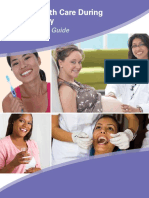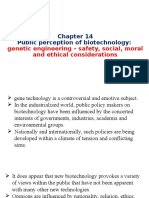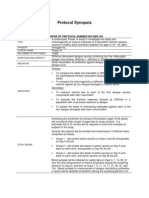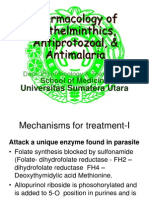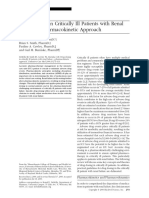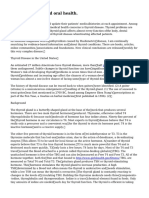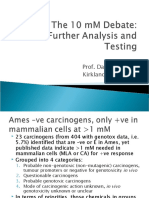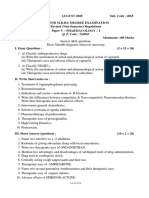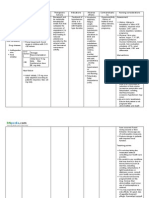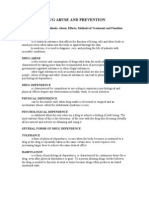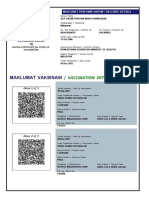Antibiotics & Analgesics Used in Dentistry
Antibiotics & Analgesics Used in Dentistry
Uploaded by
Dominique AbelaCopyright:
Available Formats
Antibiotics & Analgesics Used in Dentistry
Antibiotics & Analgesics Used in Dentistry
Uploaded by
Dominique AbelaOriginal Description:
Original Title
Copyright
Available Formats
Share this document
Did you find this document useful?
Is this content inappropriate?
Copyright:
Available Formats
Antibiotics & Analgesics Used in Dentistry
Antibiotics & Analgesics Used in Dentistry
Uploaded by
Dominique AbelaCopyright:
Available Formats
ANTIBIOTICS COMMONLY USED IN DENTISTRY
1. ANTIBIOTIC PROPHYLAXIS:
Amoxycillin 2g orally (p.o.) 1 hour before treatment in adults (kids 50mg/kg up to 2g).
Amoxy/Ampicillin 2g in adults IV (kids 50mg/kg up to 2g i.v.). Given just before
procedure. OR same doses given IM 30min before procedure.
Clindamycin 600mg p.o. 1 hour before treatment in adults, 15mg/kg in kids. Given if
allergy to penicillin/cephalosporin.
Vancomycin 25mg/kg IV over 1 hour or lincomycin 600mg/kg IV 20mg/kg and initially
the 10mg subsequenty kids).
Note: 7-18% of patients allergic to penicillin are allergic to cephalosporins.
Therapeutic Guidlines 2008 Prevention of endocarditis update: AB prophylaxis is now only recommended for patient with
cardiac conditions associated with the highest risk of adverse outcomes from endocarditis. These high risk cardiac conditions
are:
Prosthetic cardiac valves or prosthetic material used for cardiac valve repair.
Congenital heart disease including unrepaired cyanotic defects, (shunts and conduits)
Completely repaired defects with prosthetic material within 6mth of surgery.
Cardiac transplant
Rheumatic heart disease in indigenous aboriginals
Previous hx of endocarditis.
2. FOR TREATMENT OF ODONTOGENIC INFECTION
Antibiotics
Amoxycillin: Actue: 500mg t.i.d, p.o. 250mg if low grade infection.
Penicillin V: Same as above. (less incidence of thrush compared with other penicillins)
Ceflexin: 250mg q.i.d, p.o.
Metronidazole: Acute: 400mg t.i.d, po 200mg if low grade infection.
Erythromycin: Acute:500mg q.i.d. 250 if low grade infection
Doxycycline: Acute:200mg loading dose then 100mg b.i.d. In kiks 1.2mg/kg b.i.d day
one the 1-2mg once a day, p.o. NOTE: Contraindicated after 18 (16 wks postconception) weeks as they formations
of teeth and cause staining.
Augmentin: Acute 500mg t.i.d, p.o. In kids 80-90mg/kg b.i.d, p.o. based on amoxycillin
component.
Antifungals
Miconazole (or fluconazole/Ketoconazole): 2% gel 2.5mL q.i.d. for 21 days.
* Interacts with Warfarin, nifedipine, prednisone, midazolam, cyclosporin)
Nystatin: 100 000units q.i.d, p.o. for 21 days
Amphoteracin B 10mg lozenge q.i.d for 21 days
Antivirals
Aciclovir or Famciclovir: For Herpes Zoster & Bells palsy 800mg 5X a day for 7 days.
For primary herpetic gingivostomatitis 20mg/kg every 5 hours.
SITE OF ACTION, CLASS, EXAMPLE & MOA OF COMMONLY PRESCRIBED
ANTIBIOTICS
Cell membranes & cell wall peptidoglycan synthesis: -lactams ( penicillins -amoxycillin
cephalosporins - keflexin).
MOA: Inhibit cell wall synthesis in dividing bacteria via -lactam binding to penicillin binding proteins. This
prevents cell wall cross-linking. EG: Penicillins, Cephalosporins. More effective in gram positive bacteria.
Protein synthesis: tetracyclins, aminoglycosides (gentamycin), macrolides (erythro-, azithro-,
and clindamycin) and lincosamides (clindamycin).
MOA: Tetracyclins - Inhibit the 30S subunit in mRNA translation complex thus preventing the tRNA binding to
the mRNA-ribosome complex. Aminoglycosides: Some bind to the bacterial 30S ribosomal subunit
[
& some work by
binding to the 50S subunit. Macrolides: Bind to 50S ribosome subunit. Lincosamides: Block peptide bond at 50S
ribosome subunit and are only bacteriostatic.
DNA metabolism: nitroimidazoles (metronidazole, tinnidazole), sulfonamides (septra, bactrim),
rifamycin (rifampin) .
MOA: Nitroimidazoles passively disuse into cells and then the nitro group is reduced. The reduced product
oxidises DNA causing strand breaks and subsequent cell death. Sulfonamides - p-aminobenzoic acid (PABA) is
required to synthesize dihydrofolic acid which is required for nucleic acids synthesis. Sulfonamides are chemical
analogs of PABA, are competitive inhibitors of dihydropteroate synthetase. Sulfonamides therefore are reversible
inhibitors of folic acid synthesis and bacterostatic not bacteriocidal. Rifamycin Binds to RNA polymerase thus
inhibiting RNA synthesis which in turn prevents DNA synthesis.
Vitamin metabolism (eg folic acid): trimethroprim (alprim), sulfonamides (septra, bactrim).
MOA: Trimethoprim - Interfere with the action of dihydrofolate reductase thus prevent synthesis of
tetrahydrofolic acid which then prevents DNA replication and transcription. Only Bacteriacidal.
ANALGESICS COMMONLY USED IN DENTISTRY
NSAIDS:
2 types: selective and non-selective. Selective bind selectively to COX 1 or 2. COX-2 is usually
present at the site of inflammation thus this one is usually targeted (eg Celebrex).
ACTIONS: They have analgesic, antipyretic and anti-inflammatory actions.
MOA: Inhibit COX thus prevents the breakdown of arachidonic acid to prostaglandins (PGs).
PGs sensitise nociceptors. They act peripherally and centrally.
Peripheral mechanisms: Inhibition of PG synthesis at nociceptors.
Central mechanisms: Blocks PGs acting at spinal cord and higher centers to promote
pain transmission signals to brain.
ADVERSE EFFECTS: Gastric irritation, exacerbate asthma & exacerbate renal impairment.
TYPES: Aspirin, Ibuprofen, Diclofenac.
Prescription: Rx: 200-400mg (2X200mg) tablets every 4-6h, PRN.
PARACETAMOL:
ACTIONS: analgesic, antipyretic and anti-inflammatory actions.
MOA: Inhibit COX but only in CNS (i.e. central mechanisms above).
ADVERSE EFFECTS: hepatotoxicity in overdose.
NOTE: never give aspirin to children as it can cause REYES syndrome (liver damage and
encephalopathy leading to coma).
Prescription: Rx: 500-1000mg (2X500mg) tablets every 4-6h, PRN.
OPIOIDS:
Include: natural substances (opium poppy), synthetic substances (pethidine, fentanyl),
endogenous substances (encephalins, endorphins).
ACTIONS & ADVERSE EFFECTS: Analgesia, Euphoria, Respiratory depression, Antitussive,
Nausea/Vomiting, Pupil constriction, constipation, urinary retention.
MOA: Inhibit transmission of pain signals at spinal cord level by preventing primary afferent
neurons releasing neurotransmitters (presynaptic inhibition). Also prevent interneuron firing
thus allows descending inhibitory pathways to work (presynaptic inhibition).
TYPES: Codeine (panadeine forte), Oxycodone (oxycontin), Tramadol (tramal).
Prescription: Rx: Panadeine Forte tablets. Take 1 or 2, every 4-6h PRN. 40 tablets only.
You might also like
- MetLife Medical Emergencies 2007Document8 pagesMetLife Medical Emergencies 2007Atia Khalid100% (1)
- Antibacterial Agents: Chemistry, Mode of Action, Mechanisms of Resistance and Clinical ApplicationsFrom EverandAntibacterial Agents: Chemistry, Mode of Action, Mechanisms of Resistance and Clinical ApplicationsNo ratings yet
- CTD - 2.7 - 2.7.6 UpdosingDocument195 pagesCTD - 2.7 - 2.7.6 UpdosingNESTOR BARRAGANNo ratings yet
- QAS04 093rev4 FinalDocument39 pagesQAS04 093rev4 FinalRemi BoxiplentiNo ratings yet
- 11 Antiobiotics, Antifungals, and AntiviralsDocument16 pages11 Antiobiotics, Antifungals, and AntiviralseNo ratings yet
- ADA Medications PDFDocument24 pagesADA Medications PDFRoshni GehlotNo ratings yet
- Legal Aspects of Cosmetic Products: Development TeamDocument24 pagesLegal Aspects of Cosmetic Products: Development TeamkashishNo ratings yet
- 5 CC 5Document152 pages5 CC 5Sadam_fasterNo ratings yet
- Oral Health Pregnancy Res GuideDocument36 pagesOral Health Pregnancy Res GuidemargauxNo ratings yet
- 30 Local AnaestheticsDocument18 pages30 Local AnaestheticsSalmanNo ratings yet
- MDS DenistryDocument34 pagesMDS Denistrysherani999No ratings yet
- Dental PlaqueDocument9 pagesDental PlaqueDrAbhishek SinhaNo ratings yet
- Structure Based Drug Design PDFDocument3 pagesStructure Based Drug Design PDFTukai KulkarniNo ratings yet
- Campaign To Prevent Antimicrobial Resistance: Clinicians Hold The Solution!Document63 pagesCampaign To Prevent Antimicrobial Resistance: Clinicians Hold The Solution!kashifbutty2k100% (1)
- Epidemiology of Periodontal DiseasesDocument14 pagesEpidemiology of Periodontal DiseasesFrancisca DinamarcaNo ratings yet
- Root Canal Treatment ProcedureDocument6 pagesRoot Canal Treatment Procedurerishi kumar100% (1)
- Food Allergy Overview in ChildrenDocument14 pagesFood Allergy Overview in ChildrenfffreshNo ratings yet
- Honey Dressing Versus Silver Sulfadiazene Dressing For Wound Healing in Burn Patients - A Retrospective StudyDocument6 pagesHoney Dressing Versus Silver Sulfadiazene Dressing For Wound Healing in Burn Patients - A Retrospective StudyJoelNo ratings yet
- Application of rDNA in Animal Cell Culture (Animal Biotech)Document64 pagesApplication of rDNA in Animal Cell Culture (Animal Biotech)jithinnxNo ratings yet
- Molecular Allergology WebDocument401 pagesMolecular Allergology WebAna-Maria DuMiNo ratings yet
- Public Perception of Biotechnology:: Genetic Engineering - Safety, Social, Moral and Ethical ConsiderationsDocument18 pagesPublic Perception of Biotechnology:: Genetic Engineering - Safety, Social, Moral and Ethical ConsiderationsHayderNo ratings yet
- Meta-Analysis of Randomized Controlled Trials of The Efficacy of Propolis Mouthwash in Cancer Therapy-Induced Oral MucositisDocument9 pagesMeta-Analysis of Randomized Controlled Trials of The Efficacy of Propolis Mouthwash in Cancer Therapy-Induced Oral MucositisandikaisnaeniNo ratings yet
- Drug InformationDocument17 pagesDrug InformationAbhijith A pNo ratings yet
- Protocol SynopsisDocument5 pagesProtocol Synopsiscorina_lee_caseyNo ratings yet
- AICTE Sponsored SCOPE Conference Proceedings PDFDocument186 pagesAICTE Sponsored SCOPE Conference Proceedings PDFPustaka Helvetia100% (1)
- 10.1007@978 3 030 35147 2 PDFDocument286 pages10.1007@978 3 030 35147 2 PDFJonathan RoaNo ratings yet
- Immunology of Periodontal DiseasesDocument9 pagesImmunology of Periodontal DiseasesoladunniNo ratings yet
- PV of Herbals 34Document1 pagePV of Herbals 34rr48843No ratings yet
- Antisense Therapy 2020Document18 pagesAntisense Therapy 2020Calvin HansNo ratings yet
- Antifungal AgentsDocument22 pagesAntifungal AgentsQuolette Constante100% (1)
- K46 Pharmacology of Anthelminthics, Antiprotozoal, & Antimalaria (Farmakologi)Document78 pagesK46 Pharmacology of Anthelminthics, Antiprotozoal, & Antimalaria (Farmakologi)ayapillaiNo ratings yet
- Fight Cancer PDF PDFDocument6 pagesFight Cancer PDF PDFTushar Varshney100% (1)
- Method of Working Out A Case With Kent's RepertoryDocument17 pagesMethod of Working Out A Case With Kent's RepertoryAnupamNo ratings yet
- Nano MedicineDocument52 pagesNano Medicinenoe_lloNo ratings yet
- Applied Biology (PERSONALIZED MEDICINE)Document9 pagesApplied Biology (PERSONALIZED MEDICINE)HAZEL LEELA A P RICHARDNo ratings yet
- Recreating Drug DiscoveryDocument30 pagesRecreating Drug DiscoveryRushi AnandanNo ratings yet
- Drug Induced Liver Toxicity (DILD)Document39 pagesDrug Induced Liver Toxicity (DILD)Surya Pratama100% (1)
- Dental Pain and Associated Factors Among Pregnant Women: An Observational StudyDocument8 pagesDental Pain and Associated Factors Among Pregnant Women: An Observational StudyYafi HafizNo ratings yet
- Revised Pharmaceuticall NanotechDocument19 pagesRevised Pharmaceuticall NanotechSyed Ali RazaNo ratings yet
- Pharmacovigilance Paper PDFDocument19 pagesPharmacovigilance Paper PDFHassan Ahmed KhanNo ratings yet
- Probiotics - in Depth - NCCIHDocument17 pagesProbiotics - in Depth - NCCIHMuthu KumarNo ratings yet
- Drug Toxicity in Pregnancy and LactationDocument3 pagesDrug Toxicity in Pregnancy and LactationPardeep SonyNo ratings yet
- PhytochemistryDocument35 pagesPhytochemistryTheophilusNo ratings yet
- Drug Dosing Renal Failure PDFDocument41 pagesDrug Dosing Renal Failure PDFWildan Wisnu WardayaNo ratings yet
- Thyroid Disease and Oral Health.Document6 pagesThyroid Disease and Oral Health.crookedgrange6384No ratings yet
- 2019 69 1Document121 pages2019 69 1Kanchit SuwanswadNo ratings yet
- Nanomedicine (Biopharmaceuticals)Document34 pagesNanomedicine (Biopharmaceuticals)jonesharmiNo ratings yet
- PWC Personalized Medicine ReportDocument54 pagesPWC Personalized Medicine Reportsundeepbhan100% (1)
- Proceedings Book NCPP 2013, ICAR-DGR, Directorate of Groundnut Research, JunagadhDocument978 pagesProceedings Book NCPP 2013, ICAR-DGR, Directorate of Groundnut Research, JunagadhAbhay Kumar100% (2)
- Prof. David Kirkland Kirkland ConsultingDocument25 pagesProf. David Kirkland Kirkland Consultingsrikanthannabathuni4575100% (1)
- Current Advances in Breast Cancer Research: A Molecular ApproachFrom EverandCurrent Advances in Breast Cancer Research: A Molecular ApproachNo ratings yet
- Research Pharmacogenomics PDFDocument10 pagesResearch Pharmacogenomics PDFmohammedNo ratings yet
- Cancer Chemotherapy and Its ComplicationDocument49 pagesCancer Chemotherapy and Its ComplicationLina AnisaNo ratings yet
- 1a.introduction To PharmacognosyDocument17 pages1a.introduction To PharmacognosyVennelaNo ratings yet
- Unesco - Eolss Sample Chapter: Plants As A Source of Anti-Cancer AgentsDocument15 pagesUnesco - Eolss Sample Chapter: Plants As A Source of Anti-Cancer AgentsSundararajan Jeyaraman100% (1)
- New Advancements of Bioplastics in Medical ApplicationsDocument15 pagesNew Advancements of Bioplastics in Medical ApplicationsBrizeth García DíazNo ratings yet
- 100 20210811 ICOPH 2021 Abstract BookDocument186 pages100 20210811 ICOPH 2021 Abstract Bookwafiq alibabaNo ratings yet
- Fungi in Sustainable Food Production 2021Document241 pagesFungi in Sustainable Food Production 2021ela.sofiaNo ratings yet
- Mentor Meeting Presentation MobileDocument2 pagesMentor Meeting Presentation MobileDominique AbelaNo ratings yet
- Single Vs Multiple Endodontic Visits For Permanant Teeth: A ReviewDocument21 pagesSingle Vs Multiple Endodontic Visits For Permanant Teeth: A ReviewDominique AbelaNo ratings yet
- Residency ReportDocument21 pagesResidency ReportDominique AbelaNo ratings yet
- Antibiotics & Analgesics Used in DentistryDocument4 pagesAntibiotics & Analgesics Used in DentistryDominique AbelaNo ratings yet
- Download ebooks file Barile s clinical toxicology principles and mechanisms Third Edition Barile all chaptersDocument81 pagesDownload ebooks file Barile s clinical toxicology principles and mechanisms Third Edition Barile all chapterskwzmaita100% (3)
- Pharm 1Document15 pagesPharm 1Thomas CherianNo ratings yet
- Upt Puskesmas Labuhan Maringgai: Dinas KesehatanDocument7 pagesUpt Puskesmas Labuhan Maringgai: Dinas KesehatanAlief M. ZarendraNo ratings yet
- 8 PBDocument13 pages8 PBAlfy RomadoniaNo ratings yet
- Kissei PerformanceDocument23 pagesKissei PerformancelichenresearchNo ratings yet
- DAPUSDocument3 pagesDAPUSLidya AmelianaNo ratings yet
- Padma Priya Dars in I 2014Document12 pagesPadma Priya Dars in I 2014panji respatiNo ratings yet
- OSPE Block 2Document9 pagesOSPE Block 2Dr Jahidul IslamNo ratings yet
- Sustained ReleaseDocument9 pagesSustained ReleaseFenny rahmadhanyNo ratings yet
- Benazepril Hydrochloride (Drug Study)Document3 pagesBenazepril Hydrochloride (Drug Study)Franz.thenurse6888100% (1)
- Daftar Obat Ranap - MiraRevisiDocument6 pagesDaftar Obat Ranap - MiraRevisiMiraNo ratings yet
- English Dialog Assignment II Pharmacist Major Kel 2Document3 pagesEnglish Dialog Assignment II Pharmacist Major Kel 2HernamirahNo ratings yet
- 03.Dose ที่เหมาะสมของ colistin ใน CREDocument16 pages03.Dose ที่เหมาะสมของ colistin ใน CRENattawat TeerawattanapongNo ratings yet
- Ibuprofen and Acetaminophen (Tylenol)Document2 pagesIbuprofen and Acetaminophen (Tylenol)vikrizkaNo ratings yet
- Dosage Regimen: Prof. Dr. Basavaraj K. NanjwadeDocument35 pagesDosage Regimen: Prof. Dr. Basavaraj K. NanjwadeBandameedi RamuNo ratings yet
- Drug Abuse and PreventionDocument14 pagesDrug Abuse and PreventionMarijo Madriaga Lopez100% (1)
- Pricelist Des 2022Document114 pagesPricelist Des 2022keris nandaNo ratings yet
- COC EXAM QUESTION-1Document85 pagesCOC EXAM QUESTION-1emebetwelay1991No ratings yet
- Name of The Medicinal ProductDocument7 pagesName of The Medicinal Productddandan_2No ratings yet
- Rumah Sakit Umum Daerah Haji Makassar: Pemerintah Provinsi Sulawesi SelatanDocument9 pagesRumah Sakit Umum Daerah Haji Makassar: Pemerintah Provinsi Sulawesi SelatanidafezasNo ratings yet
- DDS Paracetamol Elixir (Post-Lab)Document33 pagesDDS Paracetamol Elixir (Post-Lab)Christine RanoaNo ratings yet
- Asuhan KefarmasianDocument45 pagesAsuhan Kefarmasiankamar obat pkm tamanNo ratings yet
- Bản Sao Tóm Tắt Các ThuốcDocument10 pagesBản Sao Tóm Tắt Các ThuốcHan NguyenNo ratings yet
- CFR - Code of Federal Regulations Title 21Document5 pagesCFR - Code of Federal Regulations Title 21Bhargav krishnaNo ratings yet
- AntibioticsDocument16 pagesAntibioticsVincent Raphael Baraan AcostaNo ratings yet
- Maklumat Vaksinasi: Vaccination DetailsDocument2 pagesMaklumat Vaksinasi: Vaccination DetailsAlif HazmiNo ratings yet
- GLK Afm SeptemberDocument10 pagesGLK Afm SeptemberSyamsul anwarNo ratings yet
- Generički Naziv Lijeka (Zabranjena Supstanca) Registrovani Preparati (Komercijalni Naziv) Zaštićeno Ime Lijeka Oznaka U LZS 2015 Oznaka U ATCDocument7 pagesGenerički Naziv Lijeka (Zabranjena Supstanca) Registrovani Preparati (Komercijalni Naziv) Zaštićeno Ime Lijeka Oznaka U LZS 2015 Oznaka U ATCДраган ЧолићNo ratings yet








